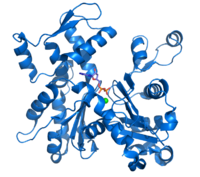
Photo from wikipedia
BACKGROUND The MYH11 gene codes for smooth muscle myosin heavy chain which has a critical function in maintaining vascular wall stability. Patients with this mutation most commonly have aortic and… Click to show full abstract
BACKGROUND The MYH11 gene codes for smooth muscle myosin heavy chain which has a critical function in maintaining vascular wall stability. Patients with this mutation most commonly have aortic and cardiac defects. Documented involvement of intracranial vessels is exceptional. CASE DESCRIPTION AND RESULTS A 29-year-old female with a history of patent ductus arteriosus (PDA) and aortic dissection was found to have incidental bilateral stenosis of the terminal Internal Carotid Arteries (ICAs) as well as the proximal Anterior Cerebral Arteries (ACAs), Middle Cerebral Arteries (MCAs) and Posterior Cerebral Arteries (PCAs) on magnetic resonance angiography (MRA) that was obtained for unrelated symptoms. There was no evidence of basal collateral formation, and a generalized "straightening" of the vessels was observed. These angiographic findings have been typically observed in patients with ACTA2 mutations. As such, genetic testing was pursued which uncovered the presence of an MYH11 mutation. 51-month follow-up imaging demonstrated that the intracranial stenosis remained stable without evidence of basal collateral formation. She has not experienced any neurological events during the follow-up interval. CONCLUSION Intracranial vessel involvement in patients with MYH11 mutations is rare. Vigilant cerebrovascular monitoring should be practiced in this population so as to guide appropriate management. Reporting of similar cases is important to improve our understanding of the development of idiopathic intracranial stenosis in young individuals.
Journal Title: World neurosurgery
Year Published: 2020
Link to full text (if available)
Share on Social Media: Sign Up to like & get
recommendations!